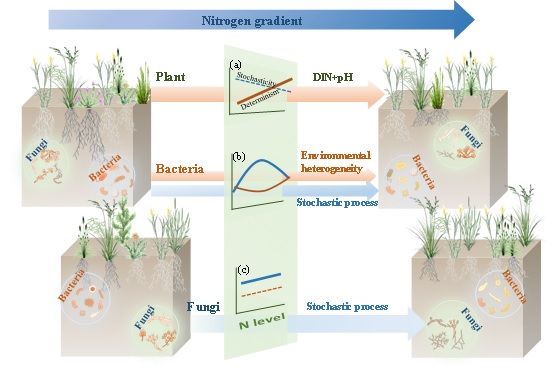Plant and soil microbial communities couple and interact with each other in terrestrial ecosystems. Environmental changes can affect plant and microbial community structure and have a profound impact on biodiversity and ecosystem function. Increasing nitrogen (N) deposition, as an important component of environmental change, is one of the major threats to biodiversity. A substantial body of literature has documented the loss of local plant and microbial diversity following N enrichment. However, we know much less about how N input influences compositional differences between local communities, an essential component of biodiversity.
A research group led by Prof. LIU Lingli from the Institute of Botany of the Chinese Academy of Sciences (IBCAS), collaborated with Prof. JIANG Lin of Georgia Institute of Technology, explored the changes in plant and microbial community diversity and the underlying mechanisms with increasing N input based on a long-term multi-level N addition experiment in a temperate steppe. This study provided the first empirical evidence that N deposition differentially influences the assembly trajectories of communities of plants and their co-occurring soil microbes.
This result was published online in Global Change Biology.
The researchers found that plant, soil bacterial and fungal communities exhibited different responses in their community assembly to N input. Increased N availability and soil acidification produced deterministic processes and dominated plant community assembly, lowering plant community dissimilarity under higher N input.
By contrast, stochastic processes strongly shaped soil fungal community assembly, resulting in high fungal community dissimilarity across the N gradient. Environmental heterogeneity induced deterministic, as well as the stochastic processes, both of which governed bacterial community assembly. The bacterial community dissimilarity first increased and then decreased with increasing N input.
These findings demonstrate differences in the assembly mechanism of plant and soil microbial communities following N deposition. This study also suggests the decoupling of plant and microbial spatial diversity under environmental changes, amplifying the potential uncertainty in predictions of ecosystem functions under global change.

Deterministic and stochastic processes in regulating plant, soil bacterial and fungal communities along a gradient of increasing N availability (Image by LIU Weixing)
Article Link: https://doi.org/10.1111/gcb.15681
Contact:
LIU Lingli
lingli.liu@ibcas.ac.cn
Institute of Botany of the Chinese Academy of Sciences
Plant and soil microbial communities couple and interact with each other in terrestrial ecosystems. Environmental changes can affect plant and microbial community structure and have a profound impact on biodiversity and ecosystem function. Increasing nitrogen (N) deposition, as an important component of environmental change, is one of the major threats to biodiversity. A substantial body of literature has documented the loss of local plant and microbial diversity following N enrichment. However, we know much less about how N input influences compositional differences between local communities, an essential component of biodiversity.
A research group led by Prof. LIU Lingli from the Institute of Botany of the Chinese Academy of Sciences (IBCAS), collaborated with Prof. JIANG Lin of Georgia Institute of Technology, explored the changes in plant and microbial community diversity and the underlying mechanisms with increasing N input based on a long-term multi-level N addition experiment in a temperate steppe. This study provided the first empirical evidence that N deposition differentially influences the assembly trajectories of communities of plants and their co-occurring soil microbes.
This result was published online in Global Change Biology.
The researchers found that plant, soil bacterial and fungal communities exhibited different responses in their community assembly to N input. Increased N availability and soil acidification produced deterministic processes and dominated plant community assembly, lowering plant community dissimilarity under higher N input.
By contrast, stochastic processes strongly shaped soil fungal community assembly, resulting in high fungal community dissimilarity across the N gradient. Environmental heterogeneity induced deterministic, as well as the stochastic processes, both of which governed bacterial community assembly. The bacterial community dissimilarity first increased and then decreased with increasing N input.
These findings demonstrate differences in the assembly mechanism of plant and soil microbial communities following N deposition. This study also suggests the decoupling of plant and microbial spatial diversity under environmental changes, amplifying the potential uncertainty in predictions of ecosystem functions under global change.

Deterministic and stochastic processes in regulating plant, soil bacterial and fungal communities along a gradient of increasing N availability (Image by LIU Weixing)
Article Link: https://doi.org/10.1111/gcb.15681
Contact:
LIU Lingli
lingli.liu@ibcas.ac.cn
Institute of Botany of the Chinese Academy of Sciences
